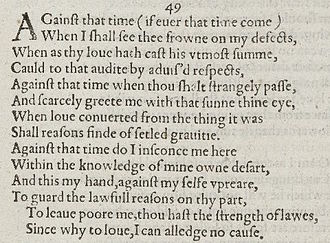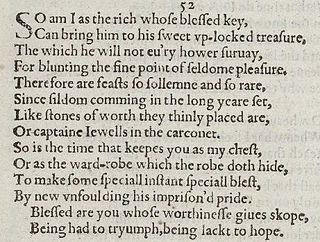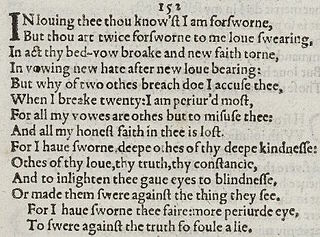| Sonnet 49 | |||||||
|---|---|---|---|---|---|---|---|
 Sonnet 49 in the 1609 Quarto | |||||||
| | |||||||
| |||||||
Sonnet 49 is one of 154 sonnets written by the English playwright and poet William Shakespeare. It is a member of the Fair Youth sequence, in which the poet expresses his love towards a young man.
| Sonnet 49 | |||||||
|---|---|---|---|---|---|---|---|
 Sonnet 49 in the 1609 Quarto | |||||||
| | |||||||
| |||||||
Sonnet 49 is one of 154 sonnets written by the English playwright and poet William Shakespeare. It is a member of the Fair Youth sequence, in which the poet expresses his love towards a young man.
Sonnet 49 is an English or Shakespearean sonnet. The English sonnet contains three quatrains followed by a final rhyming couplet, for a total of fourteen lines. It follows the form's typical rhyme scheme, ABAB CDCD EFEF GG, and is written in iambic pentameter, a type of poetic metre based on five pairs of metrically weak/strong syllabic positions. Line thirteen exemplifies a regular iambic pentameter:
× / × / × / × / × / To leave poor me thou hast the strength of laws, (49.13)
Line ten's "desert" would have been for Shakespeare a full rhyme with "part", as is suggested by the Quarto's spelling, "desart". [2]

Sonnet 38 is one of 154 sonnets written by the English playwright and poet William Shakespeare. It is a member of the Fair Youth sequence, in which the lyric subject expresses its love towards a young man.

Sonnet 44 is one of 154 sonnets written by the English playwright and poet William Shakespeare. It is a member of the Fair Youth sequence, in which the poet expresses his love towards a young man. Sonnet 44 is continued in Sonnet 45.

Sonnet 45 is one of 154 sonnets written by the English playwright and poet William Shakespeare. It is a member of the Fair Youth sequence, in which the poet expresses his love towards a young man. Sonnet 45 is continued from Sonnet 44.

Sonnet 48 is one of 154 sonnets written by the English playwright and poet William Shakespeare. It is a member of the Fair Youth sequence, in which the poet expresses his love towards a young man.

Sonnet 50 is one of 154 sonnets written by the English playwright and poet William Shakespeare. It is a member of the Fair Youth sequence, in which the poet expresses his love towards a young man. It is continued in Sonnet 51.

Sonnet 51 is one of 154 sonnets written by the English playwright and poet William Shakespeare. It is part of the Fair Youth sequence, in which the poet expresses his love towards a young man. It is a continuation of the argument from Sonnet 50.

Sonnet 52 is one of 154 sonnets written by the English playwright and poet William Shakespeare. It is a member of the Fair Youth sequence, in which the poet expresses his love towards a young man.

Sonnet 61 is one of 154 sonnets written by the English playwright and poet William Shakespeare. It is a member of the Fair Youth sequence, in which the poet expresses his love towards a young man.

Sonnet 70 is one of 154 sonnets written by the English playwright and poet William Shakespeare. It is a member of the Fair Youth sequence, in which the poet expresses his love towards a young man.
Sonnet 132 is one of 154 sonnets written by the English playwright and poet William Shakespeare.

Sonnet 134 is one of 154 sonnets written by the English poet and playwright William Shakespeare. In it, the speaker confronts the Dark Lady after learning that she has seduced the Fair Youth.

Sonnet 152 is a sonnet by William Shakespeare. It is one of a collection of 154 sonnets, dealing with themes such as the passage of time, love, beauty and mortality, first published in a 1609.

Sonnet 150 is one of 154 sonnets written by the English playwright and poet William Shakespeare. It is considered a Dark Lady sonnet, as are all from 127 to 152. Nonetheless 150 is an outlier, and in some ways appears to belong more to the Fair Youth.
Sonnet 149 is one of 154 sonnets written by the English playwright and poet William Shakespeare.

Sonnet 148 is one of 154 sonnets written by the English playwright and poet William Shakespeare.

Sonnet 119 is one of 154 sonnets written by the English playwright and poet William Shakespeare. It's a member of the Fair Youth sequence, in which the poet expresses his love towards a young man.

Sonnet 90 is one of 154 sonnets written by the English playwright and poet William Shakespeare. It is a member of the Fair Youth sequence, in which the poet expresses his love towards a young man.

Sonnet 95 is one of 154 sonnets written by the English playwright and poet William Shakespeare. It is a member of the Fair Youth sequence, in which the poet expresses his love towards a young man.
Sonnet 120 is one of 154 sonnets written by the English playwright and poet William Shakespeare. It's a member of the Fair Youth sequence, in which the poet expresses his love towards a young man.

Shakespeare's sonnet 117 was first published in 1609. It uses similar imagery to Sonnet 116 and expands on the challenge in the closing couplet. Using legally resonant metaphors, the poet defends himself against accusations of ingratitude and infidelity by saying that he was merely testing the constancy of those same things in his friend.